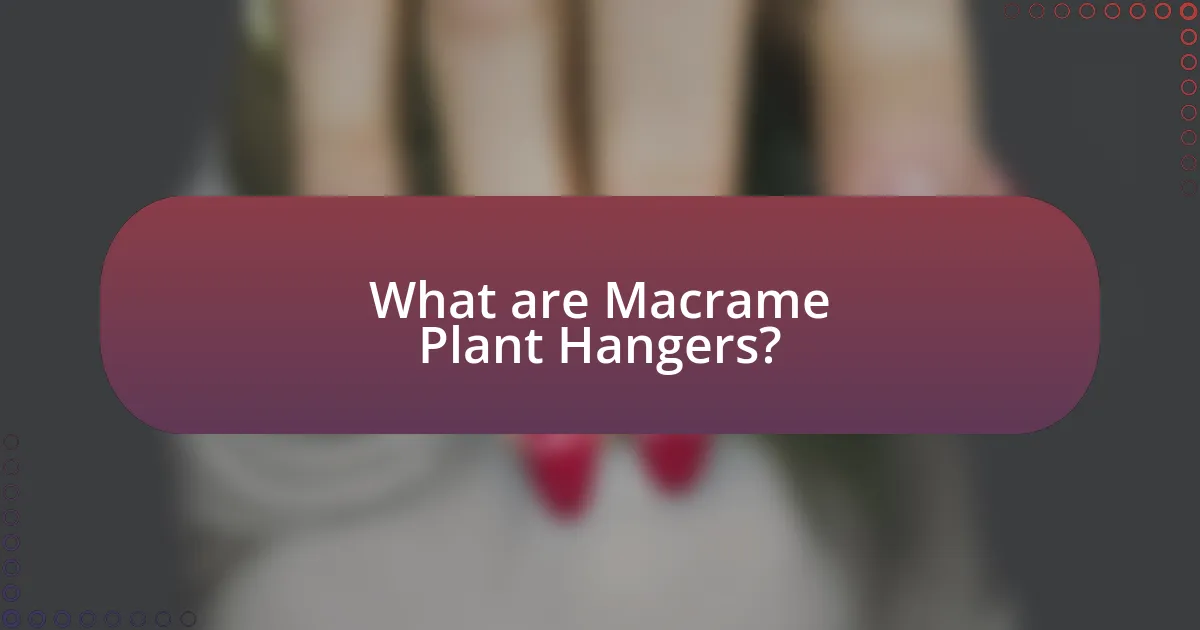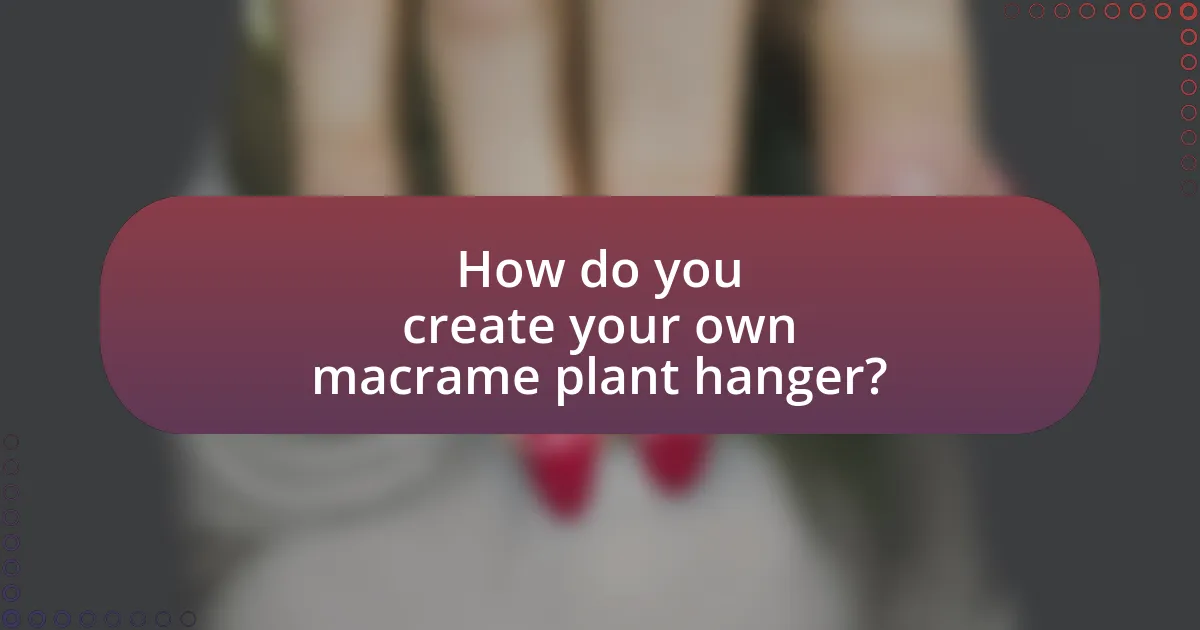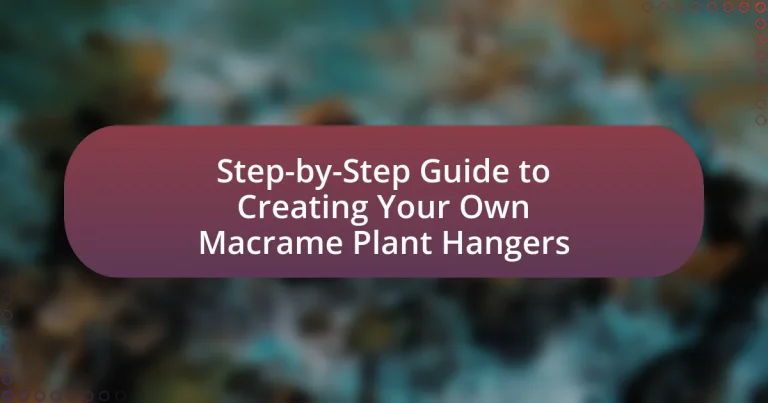Macrame plant hangers are decorative holders made from knotted cords that suspend plants, originating from ancient knotting techniques. This article provides a comprehensive guide on creating your own macrame plant hangers, detailing the historical significance of macrame, the materials and tools needed, and the essential knotting techniques. It covers the step-by-step process for crafting a plant hanger, customization options, troubleshooting common issues, and maintenance tips to ensure longevity. By following this guide, readers will gain the skills necessary to create aesthetically pleasing and functional macrame plant hangers for their indoor and outdoor spaces.

What are Macrame Plant Hangers?
Macrame plant hangers are decorative holders made from knotted cords that suspend plants from ceilings or walls. These hangers are crafted using macrame techniques, which involve creating intricate patterns through various knotting methods. Historically, macrame originated in the 13th century with Arab weavers and gained popularity in the 1970s as a home decor trend. The use of macrame plant hangers allows for vertical gardening, saving space while adding aesthetic appeal to indoor and outdoor environments.
How did macrame plant hangers originate?
Macrame plant hangers originated from the ancient art of knotting, which dates back to the 13th century when Arab weavers created decorative fringes on textiles. This technique spread to Europe, particularly in the 17th century, where it became popular among sailors who used it for practical purposes on ships. The decorative use of macrame evolved over time, leading to the creation of plant hangers in the 1970s as part of the home decor trend. This historical context highlights the transition from functional knotting to decorative applications in interior design.
What historical significance do macrame techniques hold?
Macrame techniques hold historical significance as a form of textile art that dates back to ancient civilizations, including the Babylonians and the Chinese, who used knotting methods for decorative and functional purposes. These techniques evolved through various cultures, notably during the Middle Ages when sailors utilized macrame for practical applications such as securing rigging and creating decorative items. The resurgence of macrame in the 1970s further solidified its cultural relevance, as it became a popular craft in the context of the bohemian lifestyle, reflecting a broader movement towards handmade and artisanal goods.
How have macrame plant hangers evolved over time?
Macrame plant hangers have evolved significantly from their origins in the 13th century, when they were primarily used by sailors to create decorative knots for securing items on ships. Over time, macrame became popular in the 1970s as a home decor trend, characterized by intricate knotting techniques and the use of natural fibers. In recent years, the resurgence of interest in DIY crafts and sustainable living has led to a modern revival of macrame plant hangers, incorporating contemporary designs, synthetic materials, and a variety of colors and patterns to appeal to current aesthetic preferences. This evolution reflects broader trends in home decor and a growing appreciation for handmade, artisanal items.
What materials are commonly used in macrame plant hangers?
Macrame plant hangers are commonly made from materials such as cotton cord, jute, hemp, and nylon. Cotton cord is favored for its softness and ease of knotting, while jute and hemp provide a more rustic aesthetic and durability. Nylon is often used for its strength and weather resistance, making it suitable for outdoor use. These materials are chosen for their ability to hold weight and maintain structural integrity, which is essential for supporting plants.
What types of cords are suitable for macrame projects?
The types of cords suitable for macrame projects include cotton cord, jute cord, hemp cord, and nylon cord. Cotton cord is popular for its softness and ease of use, making it ideal for beginners. Jute cord offers a rustic look and is often used for decorative pieces. Hemp cord is durable and eco-friendly, suitable for various projects. Nylon cord is strong and weather-resistant, making it appropriate for outdoor macrame. Each type of cord has unique properties that cater to different macrame styles and applications.
How do different materials affect the final look of the plant hanger?
Different materials significantly influence the final look of a plant hanger. For instance, cotton rope offers a soft, natural aesthetic that complements bohemian decor, while jute provides a rustic, earthy appearance. Synthetic materials like nylon can create a sleek, modern look but may lack the warmth of natural fibers. Additionally, the thickness and texture of the material can affect the overall visual impact; thicker ropes create a more substantial presence, while thinner cords can result in a delicate, airy design. The choice of material ultimately shapes the style and character of the plant hanger, aligning it with specific interior design themes.
What are the basic techniques involved in macrame?
The basic techniques involved in macrame include knotting, which is the fundamental method used to create patterns and designs. Common knots used in macrame are the square knot, half hitch, and lark’s head knot. The square knot consists of two alternating half knots, while the half hitch involves wrapping a cord around another cord. The lark’s head knot is used to attach cords to a ring or dowel. These techniques allow for the construction of various macrame projects, including plant hangers, by combining different knots to achieve intricate designs.
What knots are essential for creating macrame plant hangers?
The essential knots for creating macrame plant hangers are the square knot, lark’s head knot, and double half hitch knot. The square knot is commonly used for joining cords and creating decorative patterns, while the lark’s head knot serves as a foundational knot to attach cords to a ring or dowel. The double half hitch knot is crucial for creating the vertical and diagonal elements of the design. These knots are fundamental in macrame, as they provide both structure and aesthetic appeal to plant hangers.
How can beginners practice these techniques effectively?
Beginners can practice macrame techniques effectively by starting with simple projects, such as basic knots and small plant hangers. Focusing on fundamental knots like the square knot and lark’s head knot allows beginners to build confidence and skill. Engaging in tutorials, either through online videos or step-by-step guides, provides visual guidance that enhances understanding. Additionally, using affordable materials, such as cotton cord, enables frequent practice without significant investment. Research indicates that hands-on practice, combined with visual learning, significantly improves skill acquisition in crafts (Hattie, J., & Timperley, H., 2007, “The Power of Feedback,” Review of Educational Research).

How do you create your own macrame plant hanger?
To create your own macrame plant hanger, start by cutting several lengths of macrame cord, typically around 3-4 times the desired length of the finished hanger. Next, gather the cords and secure them to a ring or hook using a lark’s head knot. Then, use various macrame knots, such as square knots and half-hitch knots, to create the desired design, ensuring to leave space for the plant pot. Finally, finish the hanger by tying off the cords at the bottom and trimming any excess. This method is validated by numerous macrame tutorials and guides that emphasize the importance of knot techniques and cord lengths for stability and aesthetics.
What tools and supplies do you need to start?
To start creating your own macrame plant hangers, you need specific tools and supplies: macrame cord, scissors, a measuring tape, and a wooden or metal ring. Macrame cord is essential for knotting and forming the structure of the hanger, while scissors are necessary for cutting the cord to the desired lengths. A measuring tape ensures accurate measurements for even spacing and length, and a ring serves as the anchor point for the plant hanger. These items are fundamental for successful macrame projects, as they directly contribute to the quality and functionality of the finished product.
How do you choose the right tools for macrame projects?
To choose the right tools for macrame projects, identify essential items such as macrame cord, scissors, a measuring tape, and a sturdy workspace. Macrame cord comes in various materials like cotton, jute, or synthetic fibers, and selecting the appropriate type depends on the desired texture and durability of the project. Scissors should be sharp to ensure clean cuts, while a measuring tape aids in precise measurements for knot placement. A sturdy workspace, such as a table or a macrame board, provides stability during the crafting process. These tools are fundamental for achieving quality results in macrame projects, as they directly impact the ease of creation and the final appearance of the piece.
What are the essential supplies for making a plant hanger?
The essential supplies for making a plant hanger include macrame cord, a wooden or metal ring, scissors, and a measuring tape. Macrame cord, typically made from cotton or synthetic materials, is necessary for knotting the hanger. A ring serves as the base to hold the plant pot, while scissors are needed to cut the cord to the desired lengths. A measuring tape ensures accurate measurements for the cord lengths, which is crucial for achieving the desired design and stability of the plant hanger.
What is the step-by-step process for making a macrame plant hanger?
To make a macrame plant hanger, follow these steps: First, gather materials including macrame cord, a ring, and scissors. Next, cut the macrame cord into several lengths, typically around 3-4 times the desired length of the finished hanger. Then, attach the cords to the ring using a lark’s head knot, ensuring they are evenly spaced. After that, create the desired knot patterns, such as square knots or spiral knots, to form the body of the hanger. Continue knotting until you reach the desired length for the plant holder. Finally, create a base knot to secure the cords together, and trim any excess cord. This process allows for customization in design and length, making it suitable for various plant sizes.
How do you measure and cut the cord for your project?
To measure and cut the cord for your macrame plant hanger project, first determine the desired length of the finished hanger, typically between 3 to 5 feet. Next, multiply this length by four to account for the cord’s folding and knotting, then add an additional 10-20% for adjustments and mistakes. For example, if you want a 4-foot hanger, cut four lengths of cord at 5 feet each, totaling 20 feet. This method ensures you have enough cord for the entire project while allowing for any necessary adjustments during the crafting process.
What are the specific knotting techniques to follow during assembly?
The specific knotting techniques to follow during assembly of macrame plant hangers include the square knot, lark’s head knot, and double half hitch knot. The square knot is created by tying two overhand knots in opposite directions, providing a secure and flat finish. The lark’s head knot involves folding a cord in half and pulling the ends through a loop, which is ideal for attaching cords to a ring or dowel. The double half hitch knot is formed by wrapping one cord around another and pulling it through, allowing for adjustable tension and decorative patterns. These techniques are foundational in macrame and are essential for constructing sturdy and aesthetically pleasing plant hangers.
How can you customize your macrame plant hanger?
You can customize your macrame plant hanger by selecting different types of cords, adjusting the length, and incorporating unique knots or patterns. For instance, using cotton, jute, or synthetic cords allows for variations in texture and color, while altering the length can create different styles, such as shorter hangers for table displays or longer ones for ceiling installations. Additionally, employing various knot techniques, like square knots or spiral knots, can enhance the visual appeal and uniqueness of the design. Customization options are supported by the versatility of macrame, which has been used for centuries in various cultures, allowing for endless creative possibilities.
What design variations can you incorporate into your hanger?
You can incorporate various design variations into your macrame plant hanger, including different knot styles, materials, and color schemes. For instance, using square knots, lark’s head knots, or spiral knots can create distinct textures and visual interest. Additionally, selecting materials such as cotton rope, jute, or synthetic fibers allows for different aesthetics and durability. Color variations can be achieved by dyeing the rope or using multi-colored strands, enhancing the overall design. These variations not only personalize the hanger but also adapt it to different decor styles, making it versatile for various settings.
How can you add personal touches to your macrame project?
To add personal touches to your macrame project, incorporate unique colors, patterns, and materials that reflect your style. For instance, selecting specific cord colors or incorporating beads and charms can enhance the visual appeal and individuality of the piece. Additionally, experimenting with different knot techniques or combining various macrame styles allows for a customized design that stands out. Personalization can also be achieved by adjusting the size and shape of the project to fit specific spaces or preferences, ensuring that the final product is not only functional but also a true representation of your aesthetic.

What are some tips for successful macrame plant hanger creation?
To successfully create a macrame plant hanger, begin by selecting the right materials, including high-quality cord and a sturdy ring. Using a thicker cord, such as cotton or jute, ensures durability and ease of handling. Additionally, measuring and cutting the cord accurately is crucial; typically, lengths should be three to four times the desired finished length of the hanger.
Incorporating various knotting techniques, such as square knots and lark’s head knots, enhances the design and stability of the hanger. It is also beneficial to maintain consistent tension while knotting to achieve a uniform appearance. Finally, securing the plant hanger properly to a ceiling hook or wall bracket ensures safety and functionality. These practices are supported by experienced macrame artists who emphasize the importance of material choice and knotting techniques for optimal results.
How can you troubleshoot common issues in macrame projects?
To troubleshoot common issues in macrame projects, first identify the specific problem, such as uneven tension or fraying cords. For uneven tension, ensure that all knots are pulled tightly and consistently; this can be verified by checking the spacing between knots. If cords are fraying, consider using a lighter to seal the ends or switching to a different type of cord that is less prone to fraying. Additionally, reviewing instructional resources or tutorials can provide clarity on techniques and common pitfalls, reinforcing the importance of following guidelines closely to avoid mistakes.
What mistakes should beginners avoid when making plant hangers?
Beginners should avoid using inadequate materials when making plant hangers, as this can lead to structural failure. For instance, using weak or unsuitable cords can result in the hanger breaking under the weight of the plant. Additionally, beginners often neglect to measure the length of the cords properly, which can lead to hangers that are either too short or too long, affecting the overall aesthetic and functionality. Another common mistake is failing to secure knots tightly, which can compromise the stability of the hanger. Proper knotting techniques are essential; for example, using a square knot ensures that the cords remain secure. Lastly, beginners frequently overlook the importance of balancing the weight distribution of the plant, which can cause the hanger to tilt or fall. By avoiding these mistakes, beginners can create more durable and visually appealing plant hangers.
How can you fix knots or tension problems in your work?
To fix knots or tension problems in your macrame work, carefully loosen the affected area by gently pulling on the surrounding cords. This allows you to adjust the tension and redistribute the fibers evenly. If knots are too tight, use a blunt tool, like a knitting needle, to gently pry them apart without damaging the cords. Consistent tension is crucial for a balanced design, as uneven tension can lead to an unprofessional appearance. Properly managing tension during the knotting process ensures that your macrame plant hanger maintains its intended shape and structure.
What are the best practices for maintaining your macrame plant hangers?
To maintain macrame plant hangers effectively, regularly check for dust and debris, and clean them gently with a damp cloth. This practice prevents buildup that can weaken the fibers over time. Additionally, avoid exposing the hangers to direct sunlight for prolonged periods, as UV rays can cause fading and deterioration of the material. It is also advisable to periodically inspect the knots and overall structure for any signs of wear or damage, ensuring that the hangers remain secure and functional. These maintenance steps help prolong the life of macrame plant hangers, keeping them looking fresh and intact.
How do you clean and care for macrame plant hangers?
To clean and care for macrame plant hangers, gently hand wash them using mild soap and lukewarm water. This method prevents damage to the fibers while effectively removing dirt and dust. After washing, rinse thoroughly to eliminate soap residue, then hang the plant hanger to air dry in a shaded area to avoid sun damage. Regularly check for any signs of wear or fraying, and if necessary, trim any loose threads to maintain the hanger’s appearance and integrity.
What storage tips can help preserve your macrame creations?
To preserve your macrame creations, store them in a cool, dry place away from direct sunlight. This prevents fading and deterioration of the fibers. Additionally, avoid folding or crushing the macrame; instead, hang them or lay them flat to maintain their shape. Using breathable storage bags or boxes can also protect against dust and moisture, which can lead to mold or mildew. These practices are essential for maintaining the integrity and appearance of macrame items over time.





